zone read dive
You know the drill by now: always Denard's legs always. Michigan went away from using Denard's legs as a threat against Iowa and suffered through a day where their tailbacks averaged 3.6 yards an attempt. Against Illinois virtually every play saw Michigan threaten a Denard run, often with the additional threat of a triple option from a motioning slot receiver or fullback Stephen Hopkins
Additionally, Michigan brought back Rodriguez's old offset H-back formation. This allowed Kevin Koger to either flare backside and open up the designed cutback runs Toussaint had success with or attack the frontside of the play on QB draws and the like. This stretched Illinois out and gave Toussaint some extra creases.
Toussaint's 65-yarder on Michigan's second play demonstrates both of these changes. It's second and ten after the NT jumped he snap on the first play and Denard missed a keep read on a triple option. Michigan comes out in a formation that could be a shot from any of the last three years but for the WR tight to the line at the top of the screen, who isn't actually a WR but is TE Steve Watson. Illinois responds by shifting its linebackers to the field and half-dropping the free safety.
There are five second level defenders on this play: the three linebackers, the overhang corner, and the rolled-up free safety.
On the snap Koger starts to head backside. The slot LB charges on an exchange as the backside DE comes in unblocked:
By the mesh points defenders one and two are dead on a handoff.
CAUSE OF DEATH, DEFENDER 1: Scrape exchange designed to contain threat of a Denard keeper; Koger's backside block.
CAUSE OF DEATH, DEFENDER 2: Drop into zone designed to combat the threat of a mesh point oh noes play-action pass (that still does nothing to combat a bubble screen or quick out by Hemingway.
Denard sees the DE containing and hands off. Koger comes backside to prevent #1 from running down the line and making the play from behind. Defender three is blitzing up the middle…
…he manages to get through the small gap beween Huyge and Omameh but the two guys combine to slow him down long enough for Toussaint to hit the hole.
CAUSE OF DEATH, DEFENDER 3: Blitz picked up by Huyge and Molk.
The Illinois line creases between Schofield and Molk. With the Illinois line clearly slanting to the playside this is mostly thanks to Molk controlling the NT well enough to prevent him from getting upfield. This defense is clearly designed to get Fitz cutting to the backside of the play; Molk's block means he doesn't have to.
By the time Fitz is hitting the line, the gap is obvious.
When he's two yards past it Illinois is done.
CAUSE OF DEATH, DEFENDER 4: General uselessness of one guy in twenty yards of space against a blocker; need to maintain leverage.
CAUSE OF DEATH, DEFENDER 5: Derp. He's containing Denard Robinson, who doesn't have the ball and was never going to have the ball on this play, or he's anticipating a cutback that he doesn't wait to see develop.
ZOOM!
Toussaint gets tackled by his shirt tail because that's what always happens to Fitzgerald Toussaint.
He manages to pick up another 15 yards after the initial contact, but someone needs to get Fitz a slippery jersey.
Video
Items Of Interest
Denard's legs: all threaty and stuff. The zone read fake eliminates one linebacker, which helps the run game but isn't a miracle. When Michigan operates from under center they still eliminate a guy because all defenses leave backside ends for potential bootlegs.
Where operating from the shotgun helps Michigan is with defender #2, who has to back out into a short zone because of the threat of a quick seam over the top. The quick PA ability of the spread 'n' shred means any linebacker who sucks up and reacts is DOA.
This is enough to put Toussaint one on one with a safety. Since that safety derps it's one on none. That's a third player the threat posed by Denard in the gun eliminates. That's their starter and fourth-leading tackler, by the way. Don't know what it is about Illinois safeties and massive breakdowns on Michigan's first possession but I like it.
Molk's block: key. Illinois is slanting the line hard and trying to funnel the play back to their backside blitz. If Fitz has to cut behind Molk that blitz may or may not get home. Since he's got a crease to the side where the Illinois line slanted it has no chance.
This isn't entirely up to Molk. Zone blocking is frequently about taking the guy where he wants to go, then taking him past that point. You can see on the replay that the backside DT is slanting, then stops, then tries to extend as Fitz hits the hole. He waves an arm at him but can do no more.
If the NT pushes hard to the playside Molk is tasked with kicking him past the point he wants to end up at; with the MLB handled by two guys Fitz likely has a cut either way. But not getting blown up/shoved back/chucked provides the crease.
Flinging Koger backside: nostalgic. Michigan also did this with Hopkins when they aligned with two backs. This is likely because of a heavy dose of plays like this where Illinois takes a quick linebacker and shoots him down the line.
A few years ago Calvin Magee said he'd worry about the guy crashing from the end "when he makes the play" on stretches; Illinois's goal with this exchange is to make the guy left unblocked a quicker player with a running start. On inside zones blocking the backside guy is mandatory because all possible creases are in the danger zone.
The bubble: screamingly open here. The slot LB will blitz as the MLB drops into coverage, so… yeah:
On this play the threat of the seam still eliminates the linebacker that the bubble usually forces out of the box*. I am still in favor of at least throwing a few bubbles because they will pick up big chunks if the defense plays like this.
I'm in favor of them generally because they put pressure on the defense by restricting the ways they can align without either getting 8 yards in their face or playing games that end with Worst Waldo passes. I mean, by the snap there isn't a guy on the field with a prayer of defending a slot bubble here.
*[When it doesn't it's forcing a safety either to the line or into a dangerous game of jumping the bubble route and opening up wide open bombs.]
NOTE: I am looking to purchase a pair of tickets to Northwestern. If you've got a couple extras email me to discharge built-up beveled guilt.
Power vs zone read. A couple weeks ago I wondered if running a bunch of power had opened up the zone read again or if it was just an effect of playing Bob Diaco and Ron English. Frequent correspondent Tyler Sellhorn provides some insight:
WLBs are the bugaboo defender for the power play (double team frontside = WLB difficult to block/unblocked). They are coached to hit the window created by the inside OL stepping to the double. Playside combos of inside zone are difficult to distinguish from straight doubles.
The best defense vs. ZR is to exchange gaps between the DE and WLB (you already know this). Therefore, these two plays in concert screw with the WLB assignment-wise from a gameplan standpoint. Gap-exchange weakside means that the free defender versus power is no longer paying any attention to the RB running said power. Leaving the DE to defend the ZR by his lonesome, though, against DR...hell to pay.
Hope that enlightens.
God Bless,
Tyler Sellhorn
Since then we've seen San Diego State defend the zone read (and nothing else) ably and Minnesota defend nothing (and nothing else). A test of this theory will come against Northwestern, which may have given up 38 to Illinois but held the Illini rushing game to just 82 yards. Sacks factor in but even without those Scheelhaase and company managed just 3.1 YPC.
They also gave up 400 yards passing, so don't get too frightened.
Stretches versus outside zone. I've been using the two terms interchangeably, which Tyler suggests is mistaking rectangles for squares:
…the zone stretch, the various sweeps (including QB sweeps), pin/pull, and when the G tries to "log" the end/OLB on Down G, the Dash (frontside zone read) all try to accomplish the same thing: circle the defense and (usually) carry the ball between the numbers and the sideline.
What I am getting at is that you have made the statement that there have been zero stretches and it feels like you are implying that M is not trying to get outside when you make that statement. There are lots of ways to get the same thing as "stretch" conceptually, and Borges is trying to fit the concept into what he already has experience calling and know what to call when. For example, QB sweep was the first call against WMU.
So yeah, you keep harping on "zero stretches" when there have been plenty of attempts to get the ball outside, but M is using different blocking schemes to do the same thing. You just need to be clearer about what you are trying to say in regards to this: we should be running outside more or we should be using stretch to run outside. That is the distinction I am encouraging you to make.
Tyler Sellhorn
Right, then: I'd like to see more outside zone blocking from Michigan because they're pretty good at it and don't seem particularly good at getting outside with pin and pull stuff or toss sweeps.
Advanced not looking at the ball. Chris Brown of Smart Football had a couple of things to add in re: Michigan's NOBODY CARES WHEN WR LOOKS FOR BALL coverage technique:
Saw your picture pages on Michigan DBs playing the fade and having success playing the man versus the ball. Thought you might find this of interest from Saban.
Basically if you are even with the WR, you play the ball. If the receiver looks over his inside shoulder you look back that way; if the WR turns his outside shoulder back you turn into the WR (toward the sideline) to play the back shoulder fade.
But if you're out of phase with the guy, ie trailing him, you don't turn back to find the ball because you never will and they'll catch it; you play the man and his hands and eyes. (I get the impression that this wasn't the case last year.)
From the photos I saw on your site the Michigan DBs are doing a good job playing the man, but that's because they aren't "in-phase" with the WRs. If the throw was better they'd probably be completing the fades. But you're closer to this stuff than I am; mostly wanted to pass along the Saban points.
So Michigan's trail technique seems born of necessity. Since they don't have Charles Woodson or Leon Hall back there the best they can do is go for the PBU. We've seen Blake Countess look for the ball because he's in better position a few times.
If Countess proves to be the real deal and Michigan can get a second corner at that level we may see more DBs look back for the ball. As it is the current technique is at least an excellent stopgap.
A little outdated. This came in before the Minnesota game:
Brian,
Do you think Denard would be as effective a runner from the RB position as he is from the QB position? My gut says he would not be but can't explain why. I bring this up given his continued poor passing performance with some people clamoring for him to change positions.
Peter F
Denard wouldn't be as effective a runner because he excels in the space allowed by a spread formation. In a pro-style offense he would probably be too slight to be a tailback, at least full-time. He'd end up in the slot.
The main tactical innovation allowed by having your QB as a runner is it allows you to spread the field horizontally by adding more WRs without giving up the extra blocker. With the defense locked in on those slots—something the threat of the bubble screen enforces—a guy like Denard can pick and choose from big gaps that open up because the defense is stretched.
Handing it to a tailback without using the QB as a threat invites an unblocked guy through since there are fewer blockers in the area. Think of this like a power play: a 4-on-3 power play is more dangerous than a 5-on-4 because it's easier to find the open guy and there's more space. The shotgun provides the extra man by using the QB as a runner. That extra space means Denard can make yards by accelerating past tackles instead of breaking them.
Denard's still pretty good when things get tight, but the pounding would be worse if that was all he was doing.
Play action problems.
Brian, would like your view/analysis of Denard's play action fakes and the importance of these in the offense. It does not appear to me that Denard really sells the hand off as much as other QB's. I'll spare the comparison to Peyton Manning. A good play fake can open up zones in the secondary and give Denard more time to make his reads as the defense should be crashing on the running back. Or, is this less of an issue in a zone read offense since there is basically a play fake on the majority of plays.
It appears to me Borges likes to throw off play action and if the QB is not selling it, that might account for some of the pressured throws we have seen from Denard so far. (disclaimer about adjustment to learning a new offense a given)
Thanks,
Trueblueintexas
There are two entirely different playfakes Denard is executing. There's one from under center and one from the shotgun. It is possible that Denard's fakes from under center are not convincing, but I think the bigger problem is that the run game is not threatening. When you're averaging three yards a carry, safeties don't have to worry about your run game because it's not getting to them. I'll keep an eye out if we get more play action from the I-form later in the year. It's possible he's a problem there since he hasn't really practiced that skill.
The shotgun is a different matter. When Michigan goes play action from the shot gun it's either Denard stepping to the line or a zone read fake. Both are inherently convincing. In the first Denard is moving towards the LOS as the offense run blocks. In the second they are executing the mesh point exactly as they would on a running play. Unless the line is doing things that tip off the opponent there's no difference. The sheer number of hand-wavingly wide open dudes on shotgun PA should be sufficient evidence that Denard's doing just fine with his fakes there.
Linebacker blaming.
Brian,
I'm reading the SDSU preview and you say that Demens and Hawthorne have to get better at diagnosing plays quickly. This appears to be a consistent theme with M linebackers over the last few years. I would assume that this "skill" is probably the easiest to evaluate when recruiting high school players as HS offenses are pretty run heavy. Did our coaches completely drop the ball in recruiting these guys or did they believe diagnosing plays is something that can be taught and, thus, focused more on the recruit's physical traits/potential?
Thanks!
I'm not sure that skill is easy to evaluate because a lot of high school kids don't get much coaching and what they get is of debatable value. You might be able to detect a kid who just Gets It, but plenty of college-level athletes who look clueless early develop into excellent players with college coaching. Prescott Burgess and Shawn Crable are two examples in recent Michigan history.
In the case of Michigan's current starters, the Great Rodriguez Defensive Coaching Malpractice is probably more at fault than recruiting. The current LB crew has been coached by Jay Hopson, Greg Robinson, and Adam Braithwaite. Braithwaite has the best resume of all of those guys by virtue of not having one. They've also swung from one system to another and, in the case of Herron, Hawthorne, and Cam Gordon, from one position to another. If these guys weren't having trouble diagnosing plays that would warrant creating a golden idol resembling Mark Smith.
As it is I think they're doing as well as can be expected. Hopefully we'll see the improvement we never got under the GRDCM as the season progresses.
Last week in Picture Pages we saw one of Michigan's counters to the "scrape exchange" that Western ran constantly last game. Michigan ran a ton of bubble screens or "long handoff"* routes and gave Forcier another option after he decided to pull the ball out: run or toss it to a (usually) wide open receiver. Once Forcier got over some early jitters, this worked well.
Notre Dame was determined to take that away:
This is Michigan's first drive of the second half. Michigan's moved the ball and just got a gashing Brandon Minor run on a zone stretch. They're going to play off that success here.
You can see Notre Dame's response to what they saw in the Western game: line up in press coverage all day, including over the slot receiver. There will be no bubbles here. To prevent Notre Dame from being outnumbered in the box, 80% of the time Notre Dame walks one or both safeties up just before the snap. And to deal with the zone read, Notre Dame is running a scrape exchange every play. (Reminder: on a scrape exchange the backside DE just hauls ass for the tailback and a linebacker pops out to contain the QB.)
Notre Dame has countered Michigan's counter to their counter and pretty much shut down Michigan's rushing attack in the first half. But it's time for the counter-counter-counter-counter.
Here's the snap as it approaches the handoff point. Note that 1) there's no bubble available and 2) Kevin Koger is pulling across the formation. Oh and 3) Moosman, who is the second OL from the top, is just drive blocking his guy instead of taking zone steps to the left in an attempt to get his helmet across. His ability to shove the DT back a yard or two is key to this play.
A couple of moments later, Michigan's diabolical plan is revealed:
Points of interest:
- Kevin Koger's pull block pops the backside defensive end, providing a lane between that guy and RG David Moosman.
- Mark Huyge gets a free release on the linebacker, who you can see moving upfield and to the outside to contain Forcier. When he realizes Forcier does not have the ball he will have run himself into a spot where Huyge has a great angle to block him.
- Molk and Moosman have terrific angles to block their guys. Why are these blocks so easy? Notre Dame is anticipating a stretch play, which is what Michigan usually runs from this formation, and if it was a stretch play it would be imperative for them to get playside of their blockers. On this counter, that expectation runs them into places where it's easy to seal them away from the play.
This is basically over. A moment later, you can see the motion of the scrape linebacker has taken him into Huyge's block and that Moosman and Molk have locked up their defenders. Brandon Minor doesn't even have to cut:
Zip!
The play ends at the one yard line. Watch it in glorious Youtube-o-vision:
Minor misses a cut on first down, Forcier fumbles on second, and a pitch gets blown up on third; Michigan misses a chip shot field goal, providing yrs truly with a wave of despair. But it ended well: Michigan was provided a short field on the next drive after a Notre Dame fumble and went from the 26 to the 7 with a six-yard stretch and 13 more on this play; that drive ended in a touchdown.
*(I don't have good lingo for that. Basically, the outside receiver stands there.)
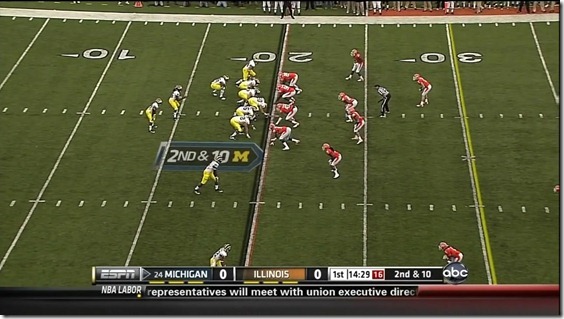
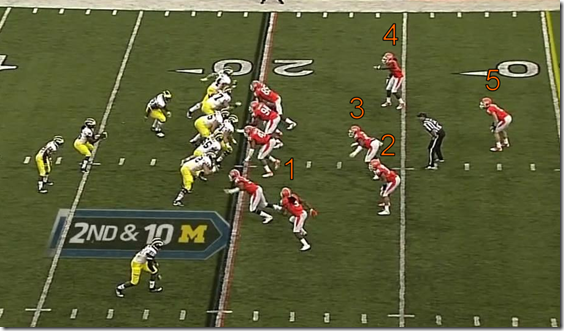

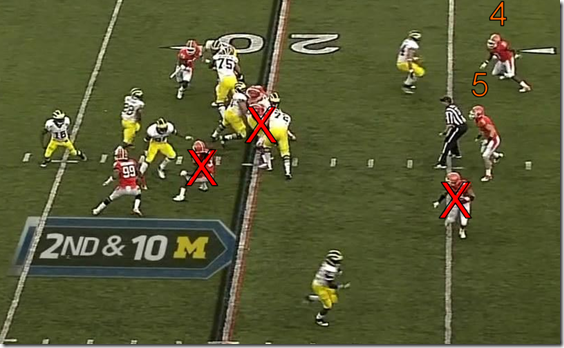
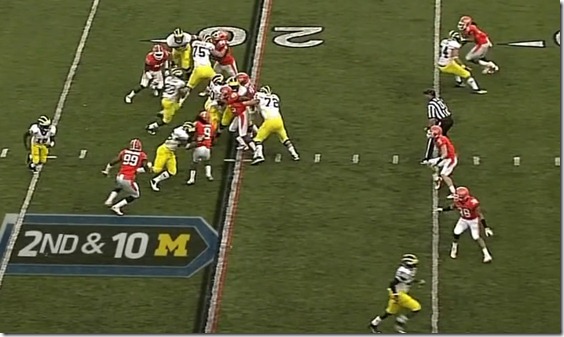
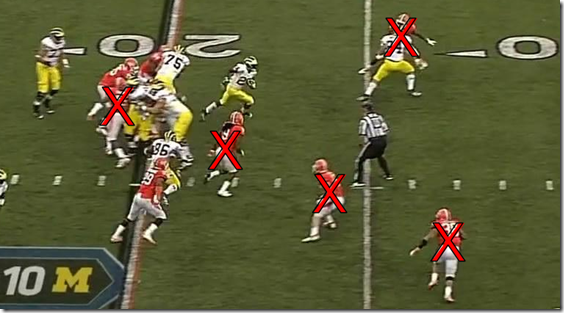
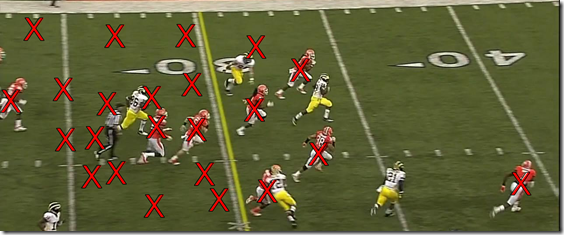
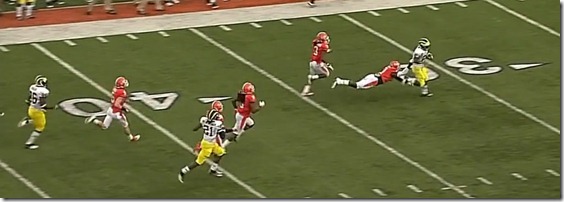
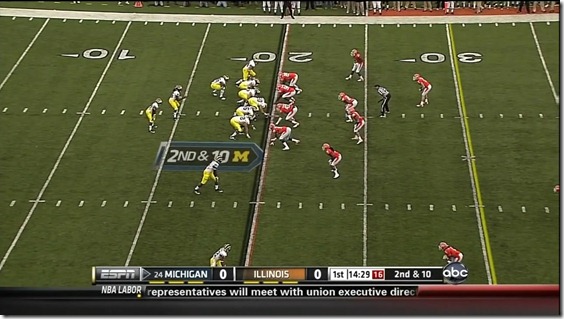
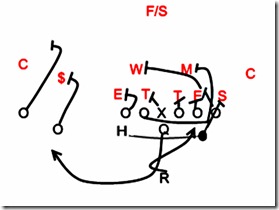
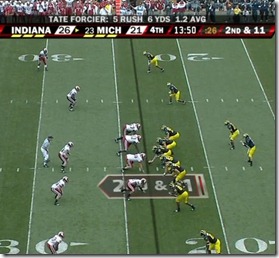
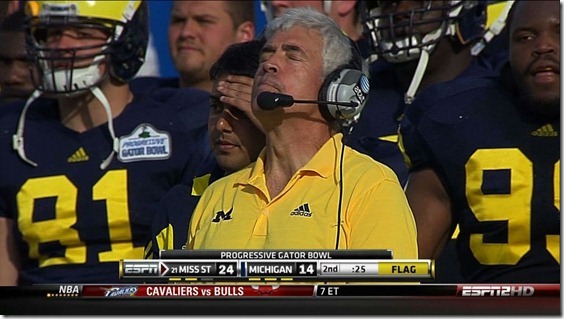
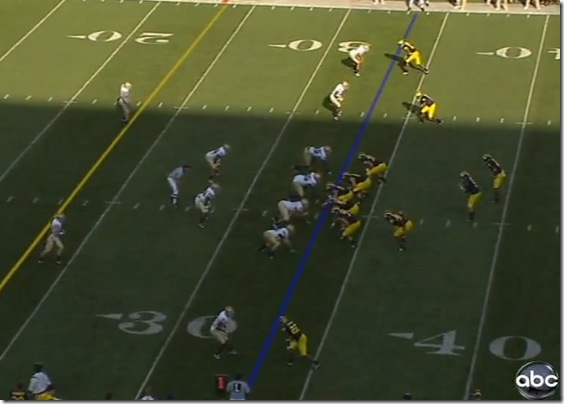
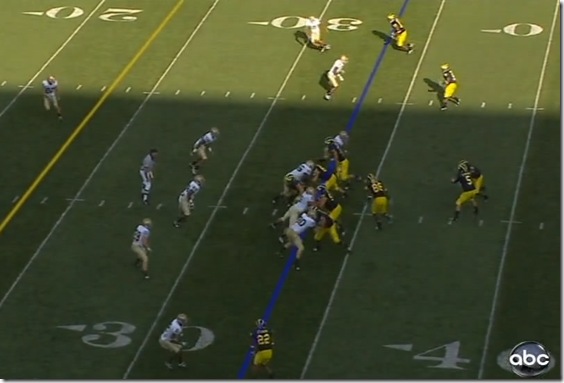
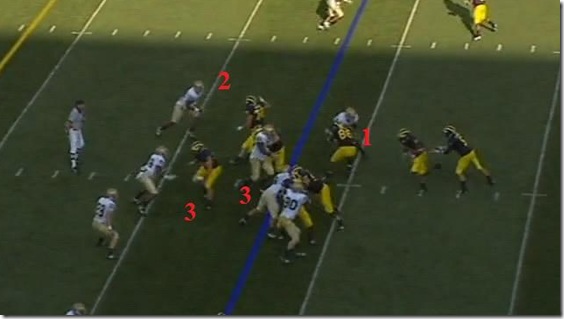
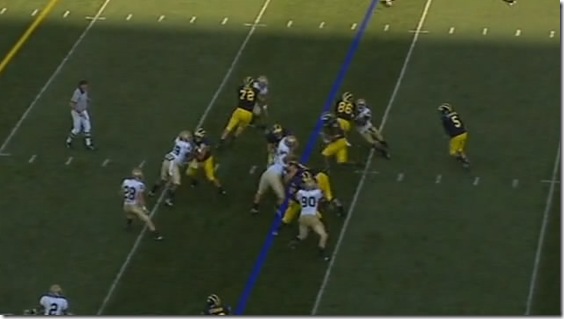
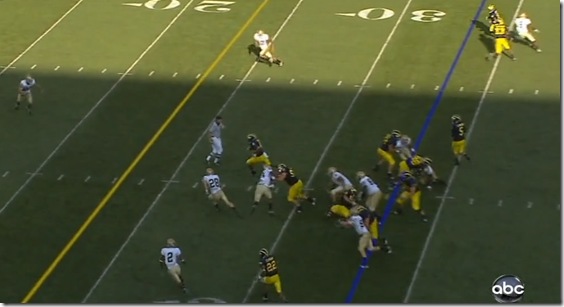
30